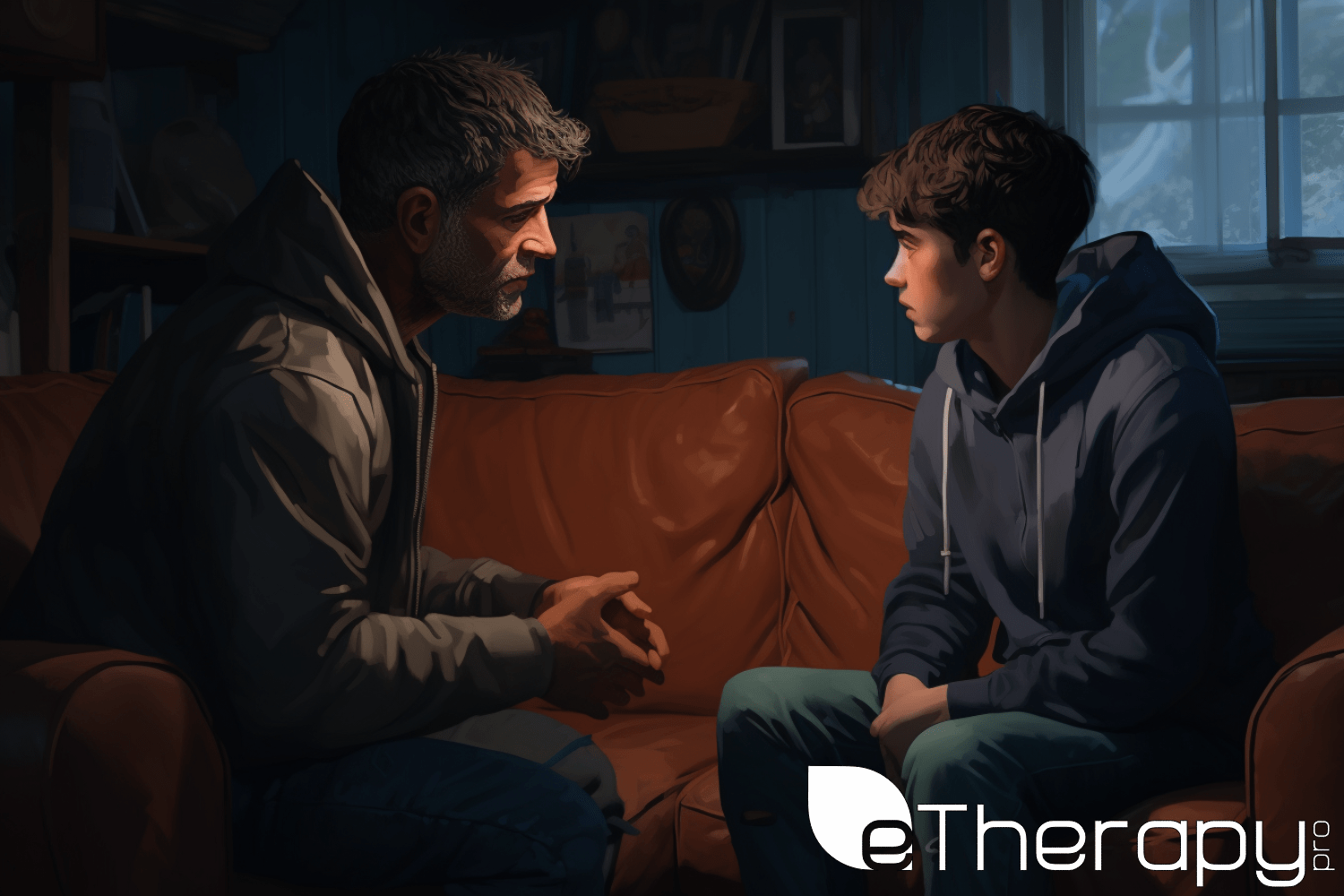 The teenage years have always been a period of emotional tumult, but today’s digital age, filled with social media pressures and academic expectations, has amplified these challenges. “Is my teen in distress?” It’s a question many parents grapple with, especially when faced with alarming behaviors like self-harm, a manifestation of Teen Stress and Anxiety, or even Teenagers and Depression.
The teenage years have always been a period of emotional tumult, but today’s digital age, filled with social media pressures and academic expectations, has amplified these challenges. “Is my teen in distress?” It’s a question many parents grapple with, especially when faced with alarming behaviors like self-harm, a manifestation of Teen Stress and Anxiety, or even Teenagers and Depression.
A day in the life of a modern teen involves juggling schoolwork, seeking peer acceptance, and navigating the online world where likes and comments often dictate self-worth. This context sets the stage for our exploration into the underlying causes and signals of distress in teens.
Our aim? To provide parents with insights into the reasons teens might resort to self-harm, and emphasize the importance of open conversations at home. Together, we’ll delve into understanding and supporting our teens, ensuring they get the assistance they might need.
The Unseen Struggle: Teens in Distress
As teens transition from childhood to adulthood, they experience a whirlwind of emotions, changes, and challenges. The lines distinguishing regular teenage behavior and genuine cries for help often blur, making it imperative for parents to be more vigilant and understanding.
The Modern Teenager: A Day in the Life
Dawn breaks and the sound of an electronic melody pierces the silence. A teenager, let’s call him Jake, groggily reaches out for the source: his smartphone, serving as an alarm, a window to the world, and so much more. As Jake pushes the covers off, he’s already scrolling through notifications, glimpsing a patchwork of overnight messages, trending news, and reminders.
Jake’s day is a whirlwind of stimuli, only a fraction of which are tangible. While his parents remember a world of handwritten notes, dial-up internet, and the thrill of waiting for their favorite show’s weekly episode, Jake’s reality is markedly different. His world is instantaneous, diverse, and vast, but it comes with its own unique challenges.
The journey to school is punctuated by the soft glow of screens – from the kid engrossed in a mobile game to the girl video chatting with a friend who moved away. During class, Jake’s laptop is both a savior and a distraction. While he types away his notes, multiple tabs remain open: one for a research assignment, another playing soft background music, and yet another with a group chat buzzing with the latest gossip.
The Social Media Maze
Lunchtime isn’t just about food. It’s a time to compare and discuss the latest TikTok trends, debate over a controversial tweet, or even discuss an intriguing podcast episode. Jake feels the pressure to stay updated, to fit in, to have an opinion. For every laugh shared over a meme, there’s a whisper about someone’s latest Instagram post, fueling the ever-present undercurrent of social hierarchy.
By evening, after school clubs, homework, and family time, Jake is exhausted. Yet, the pull of the online realm is relentless. A quick check on social media, intended to last just a few minutes, often spirals into hours. The blue light from his screen competes with the night outside, as he grapples with both FOMO (Fear Of Missing Out) and the urge to disconnect.
Back to the Digital Dilemma…
In today’s digitally-driven era, the line between the real and virtual world often blurs, especially for teenagers who’ve grown up with a smartphone in hand. Understanding the profound influence and repercussions of this online realm is essential for parents looking to fully grasp the modern teenage experience.
The Allure of the Screen
Teenagers are naturally drawn to novel experiences and social interactions, and the digital world offers an abundance of both. Online platforms promise connectivity, entertainment, and self-expression. However, they also come with their own set of challenges:
Social Media and Self-Esteem
The dopamine-driven feedback loops of likes, shares, and comments can distort a teenager’s sense of self-worth. While positive feedback can be an ego boost, a lack of it or negative comments can significantly dent their self-esteem.
Information Overload
The vast amount of information available online can be overwhelming. From news and global events to academic pressures and personal interests, teens are exposed to a constant stream of data, which can sometimes lead to anxiety or feelings of being overwhelmed.
Decoding Teen in Distress and Anxiety
The term “growing pains” isn’t just about the physical aspect. Teenagers today face a plethora of pressures ranging from traditional to those birthed in the digital age. It’s a landscape riddled with potential pitfalls, where age-old problems like academic pressures or peer acceptance intersect with newer challenges like social media comparison and cyberbullying.
Common Triggers
Understanding the origins of these stressors can provide parents with a clearer perspective.
- Social Media Pressure: While intended for connection, it can foster feelings of isolation, inferiority, and cyberbullying.
- Academic and Extracurricular Pressures: The pressure to excel and “stand out” can be daunting.
- Life Changes: Divorces, familial issues, relocating to a new place, illness in the family, or even the introduction of new family members can profoundly impact a teen’s mental well-being.
- Peer Pressure and Acceptance: The longing to “fit in” or be a part of a group can lead to immense internal turmoil.
Signs of Anxiety in Teens
A significant part of parenting involves discerning between a teenager’s identity quest and potential red flags indicating deeper issues.
Behavioral Changes: Pulling away from family, shifting friendship circles, or aligning with new peer groups can indicate underlying issues.
Academic Shifts: A sudden drop in grades might not just be laziness. It can be a silent plea for attention or help.
Physical and Appearance Changes: Over-the-top makeup, drastic changes in dressing style, or a significant alteration in personal hygiene can be signs.
The challenge lies in understanding whether these are phases in their identity search or genuine cries for assistance. When it’s the latter, teens often exude negativity or anger. While these might appear as classic “teen attitudes”, prolonged manifestations should concern parents. However, the silver lining is that such behaviors or signs, while alarming, may be short-lived.
Parents must approach such situations with sensitivity, avoiding drama or overt reactions. Overreacting can inadvertently amplify the teen’s distress. The key is to be present, listen, and offer a safe space for conversation.
Teenagers and Depression: Beyond Mood Swings
Teenage years come with their fair share of mood swings. But, it’s crucial to understand that there’s a vast difference between the typical teenage temperament and the deep-seated feelings of depression. Recognizing and addressing these subtle differences can help parents guide their teenagers through challenging times and foster a better understanding of their emotions.
What mental health needs is more sunlight, more candor, and more unashamed conversation. – Glenn Close.
This journey of adolescence, while undoubtedly challenging, also offers moments of bonding, understanding, and growth for both parents and teenagers. Being informed, staying connected, and providing a listening ear can make a significant difference in navigating these pivotal years.
 From Misunderstanding to Empathy
From Misunderstanding to Empathy
In the intricate tapestry of teenage life, each thread tells a story. Often, one of the more painful tales woven into this fabric is that of self-harm. As we further explore the complex realm of teenage distress, it’s essential to shine a light on this sensitive issue, ensuring that it’s approached with understanding, empathy, and care.
Every Scar Tells a Story: Understanding Self-Harm
Self-harm, often manifesting as behaviors like cutting or burning oneself, is a tangible reflection of an internal struggle. Contrary to some misconceptions, it’s not merely an attention-seeking act. Instead, for many teens, it’s a way to cope with overwhelming emotions, stress, or anxiety. By focusing on physical pain, some find temporary relief from the emotional turmoil swirling inside.
Key Points to Remember:
- It’s a Cry for Help, Not Attention: While self-harm might appear as a dramatic call for attention on the surface, it’s essential to understand it as a deeper cry for help. The act itself is usually private, hidden from friends and family, highlighting the silent nature of the suffering.
- Physical Manifestation of Emotional Pain: The act of self-harming can serve as a tangible release for abstract emotional pain. Teens might find the physical pain a distraction, a means of feeling “real,” or a way to externalize internal hurt.
- It Doesn’t Always Indicate Suicidal Intentions: While self-harm and suicidal tendencies can sometimes overlap, not every teen who self-harms is suicidal. However, it’s still crucial to address self-harming behavior as it reflects significant emotional distress.
Bridging the Gap with Empathy
Approaching a teen suspected of self-harming requires delicacy and compassion. As parents or guardians, the instinct might be to confront or control, but what’s needed is a gentle touch, an open heart, and a listening ear.
Steps to Connect:
- Avoid Judgment: The first reaction might be shock or disappointment, but it’s essential to approach the situation devoid of judgment. Understand that this is their way of coping, even if it’s harmful.
- Open Conversations: Create a safe space for your teen to express their feelings. Let them know they’re heard, understood, and supported. Use phrases like, “I’m here for you,” rather than, “Why are you doing this?”
Loneliness does not come from having no people around, but from being unable to communicate the things that seem important to oneself. – Carl Jung
- Seek Professional Help: While parental support is vital, sometimes professional intervention is necessary. Therapists or counselors trained in adolescent mental health can provide the guidance and tools your teen might need.
Remember, your teen’s journey through these tumultuous years is a shared one. By cultivating a space of understanding and empathy, the road ahead can be navigated with mutual respect and love.
Warning Signs in Teenagers
Following our exploration into the world of self-harming and its intricacies, it’s essential to emphasize the importance of prevention and healing. We can take the first steps towards understanding and noticing the early signs in our teenagers. As parents, guardians, or caregivers, we must be ever-vigilant, ensuring that we don’t overlook the subtle shifts in behaviors and emotions. The journey through teenage distress is like navigating a complex maze; however, with the right knowledge and empathy, we can guide our teens toward the light, ensuring they receive the assistance they need before they’re lost in the shadows.
Developmental Challenges vs. Deep-Seated Pain
Adolescence is a pivotal stage in Erik Erikson‘s stages of psychosocial development, termed “Identity vs. Role Confusion.” During this phase, teenagers grapple with understanding their identities, often leading to exploration and experimentation in various facets of life. It’s natural for teens to rebel, question authority, or even change friendship groups as they carve out their unique identity.
When Teenage Struggles Run Deep
However, while rebellion and mood swings can be chalked up to developmental challenges, there are times when the pain runs deeper. When teens consistently exhibit behaviors of withdrawal, extreme mood swings, or signs of self-harm, it’s an indication of an emotional turmoil surpassing typical teenage challenges. Such manifestations aren’t mere phases of ‘finding oneself’ but may represent struggles that the teen finds overwhelming to cope with alone.
It becomes crucial for caregivers to strike a balance between providing space for their teen’s self-discovery and intervening when the signs suggest that their emotional pain is becoming unbearable. Recognizing the difference ensures that teens aren’t pushed further into distress and are instead guided toward appropriate channels of support and healing.
Teen in Distress: The Psychology of Pain
Delving into the reasons teens might resort to self-harm, it’s imperative to understand the profound psychological pain lurking behind these actions. Many people find it strange that inflicting physical pain might seem like a way to deal with emotional turmoil, but the teenage brain can sometimes see it as a temporary escape or relief.
Understanding the Brain’s Pain Processing
The human brain processes emotional pain and physical hurt via overlapping neural pathways. This shared mechanism can sometimes cause an individual to interpret severe emotional distress as a tangible, physical sensation. In teens, where emotions can often be amplified due to hormonal changes and the ongoing process of brain development, these feelings can be particularly intense. It’s not just about the pain they’re trying to escape, but also the control they feel when self-harming, momentarily alleviating the feelings of teen stress and anxiety or even teenagers and depression.
Why Some Teens Resort to Self-Harm
Peeling back the layers of a teen in distress, one might find that self-harming is a manifestation of an internal chaos they can’t articulate. The act can represent a myriad of sentiments: punishment for perceived wrongs, a cry for attention, or even just a desperate attempt to feel something in a world where they feel numb. It’s an intricate combination of the mental battles they’re undergoing, be it mental illness in teens or the overwhelming pressure from their environment.
People with borderline personality disorder are like people with third-degree burns over 90% of their bodies. Lacking emotional skin, they feel agony at the slightest touch or movement. – Dr. Marsha Linehan
While not every teen who self-harms has this condition, the sentiment behind the quote illustrates the deep emotional pain they might be experiencing.

Teen in Distress Listen First, Act Later
In our fast-paced world characterized by immediate reactions, solutions, and judgments, we sometimes forget the value of patient understanding, especially when it concerns our teens. Warning signs in teenagers often scream for attention, but the subsequent steps require sensitivity, patience, and a lot of listening.
The Value of Active Listening
Listening doesn’t merely mean hearing words. Active listening involves absorbing, reflecting upon, and responding to what one’s teen communicates. Validating a teenager’s feelings can create a safe space for them, reducing feelings of isolation or being misunderstood. Active listening becomes a cornerstone in comprehending and supporting a teen struggling with their mental well-being.
Fostering Trust with Teens
Trust is a two-way street. Teens are more likely to open up when they feel their words won’t be met with immediate judgment or repercussions. Building trust involves being present, creating a non-confrontational environment, and assuring them that their feelings matter. Open dialogues can help teens understand their struggles and find solutions.
Teen in Distress Prevention and Healing
The complexities of adolescent emotions can sometimes manifest as deeply concerning behaviors, like self-harm. As parents, our instinct might lead us toward panic or self-blame. But remember: your teen’s distress isn’t a reflection of your parenting. Instead, they need you to be their calm anchor. Here’s how you can offer unwavering support.
Creating Safe Conversational Spaces for Teen in Distress
Consider this your first-aid kit when faced with the reality of self-harming in your teen. These tools will guide your response, ensuring your approach is supportive and understanding:
- Stay Calm: Your emotional state directly impacts your teen. If they discuss self-harming or other challenging topics like teen stress and anxiety, maintain your composure. Your calmness reassures them that they can confide in you.
- Address the Shame: Teenagers often hide self-harming behaviors because they feel ashamed, thinking something is “seriously wrong” with them. Normalize their feelings and struggles. As Fred Rogers wisely said, “Anything human is mentionable, and anything mentionable can be more manageable.” Remind your teen of this. Tell them their feelings are normal and manageable with support.
- Avoid Self-blame: Identifying signs of mental illness in teens can push parents into self-blame. But the healing journey starts when the focus shifts from self-doubt to proactive assistance.
- Be an Active Listener: Teens often seek understanding over solutions. Validate their feelings without judgment, ensuring they know they’re heard.
- Use Affirming Language: Phrases like, “I’m here for you,” “We’ll navigate this together,” or “Your emotions are valid,” can significantly comfort a distressed teen.
The Role of Professional Guidance
Knowing when to seek external support is vital:
- Identify the Right Therapist: Find professionals trained in adolescent mental health. Their specialized knowledge can guide your teen effectively.
- Embrace Group Therapies: Listening to peers share similar experiences helps teenagers realize they’re not alone in their feelings.. This sense of community is therapeutic.
- Digital Platforms: Modern solutions like eTherapyPro cater to teens by offering online counseling. Such platforms can bridge the gap for teens hesitant about traditional therapy.
Conclusion of Teen in Distress
The delicate phase of adolescence, characterized by both thrill and tribulation, presents today’s teens with a spectrum of challenges. Social media, despite its undeniable benefits, throws new hurdles our way (or creates new challenges for teenagers). Peer achievements and polished
online lives can increase comparison, isolation, and cyberbullying. Teenage years are often marked by emotional highs and lows, but the growing prevalence of self-harm is a concerning trend. It’s important to understand that these actions aren’t primarily about seeking attention; they are often a desperate attempt to cope with overwhelming emotions. Our research suggests that beneath the surface of teenage behavior lies a deeper struggle for identity, acceptance, and self-worth.
So, where do we go from here? It’s crucial that as caregivers, educators, and society at large, we offer more than just fleeting concern. Active listening, devoid of immediate judgment or the urge to provide instant solutions, can serve as a powerful tool. It’s about offering a safe space where teens feel heard, valued, and understood.
Preventing Teenage Self-Harm: A Proactive Approach
Teen self-harm needs proactive solutions. Early mental health, resilience, and emotional intelligence education can help. Real-world interactions and less digital validation can improve self-worth.
 From Misunderstanding to Empathy
From Misunderstanding to Empathy
